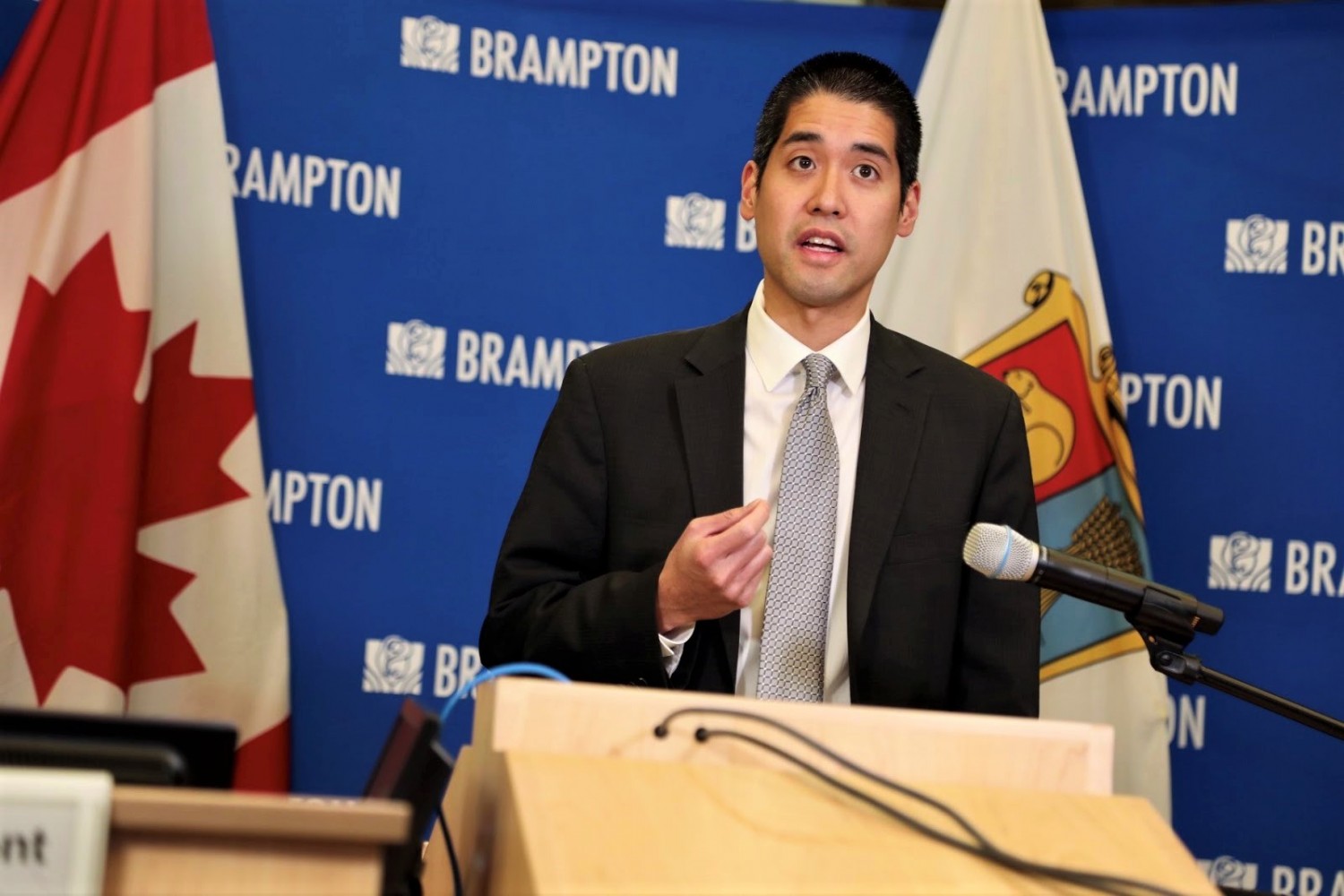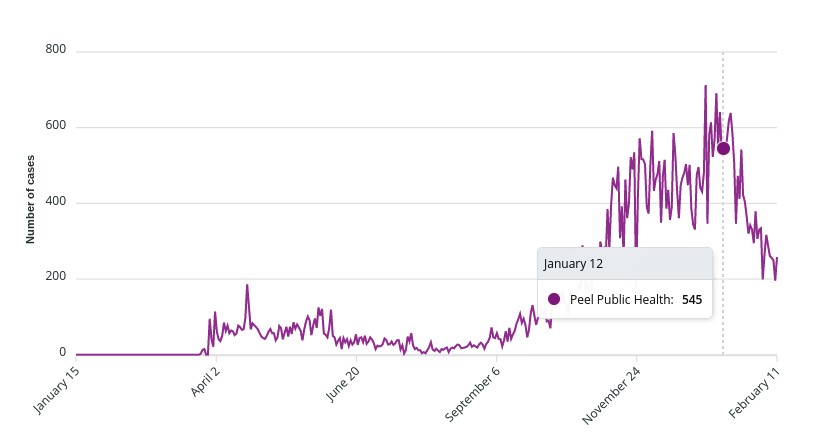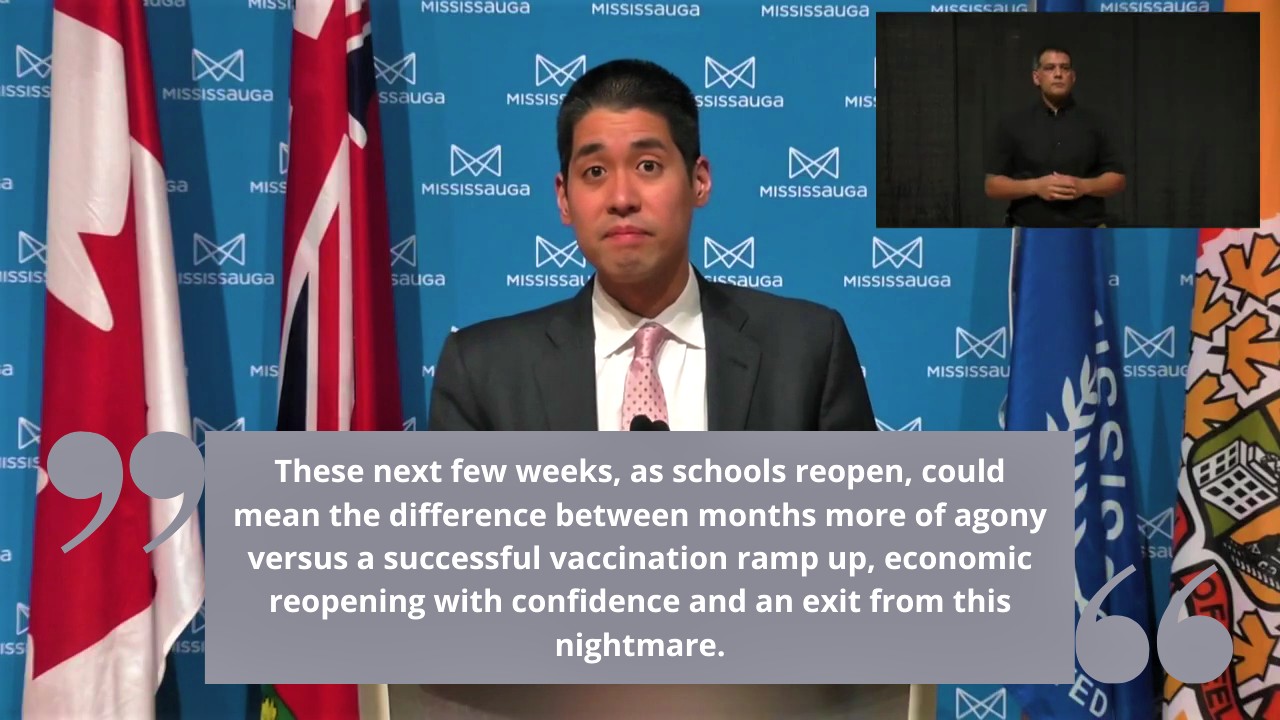
Province ignores advice of Peel’s top doctor who says reopening too soon could cause third wave
In the Region of Peel, public health officials face a dilemma: While daily case counts decline, reopening too soon could lead to a third wave.
The Region’s top doctor has called for school reopenings, which will happen on Tuesday in Peel, to be followed by a period of analysis to determine the effects of welcoming students back into classrooms. But his advice to the Province has been ignored, as it has released plans to reopen some retail just six days after schools reopen.
The region remains an Ontario hotspot and is still recording figures that would have seen hospital managers blanche in horror as late as September.
After Peel’s second wave peaked at 775 cases on January 13 (compared to 189 at the height of the first wave) officials are finally reporting improved numbers. On February 10, the region had 280 new infections, and on the 11th there were 269 reported (these figures could be updated) showing a marked improvement following a Province-wide stay-at-home-order and school closures.

According to Peel Region's most recent weekly epidemiological report, released February 12, Peel's infection incidence rate for the week that ended February 6 was 120.9 per 100,000 residents, Brampton's was 155.7 and Mississauga's was 103.4. The test positivity rate for the same week was 6.7 percent in Peel, 7.9 percent in Brampton and 5.7 percent in Mississauga.
These figures compare to the week that ended January 23, when Peel's incidence rate was 182.9 per 100,000 residents, Brampton's was 245.2 and Mississauga's was 145.1; while test positivity sat at 9.7 percent in Peel, 11.8 percent in Brampton and 8 percent in Mississauga (test positivity above 2.5 percent indicates viral transmission in an area is not under control).
Buoyed by progress that has pulled the healthcare system back from the brink, slightly, Queen’s Park is pushing ahead with a reopening plan and returning to its colour-coded system. On February 22, residents in Peel will go from living under a stay-at-home-order to living under lockdown. Schools return on February 16, after the Family Day weekend. But hospitals in Peel are still under immense pressure. According to the latest reporting by the Region, acute care capacity in Peel's hospitals for the week ending February 8 was 95 percent, well beyond the danger point of 90 percent. Intensive care capacity had a slight buffer, sitting at 82 percent during the same period.
The transition will see all retail open at strictly limited capacities, with personal care services, indoor dining and gyms all still closed.
On Wednesday, Dr. Lawrence Loh, Peel’s medical officer of health, revealed the provincial reopening plan stands in direct contrast to the advice he offered Queen’s Park. The Region’s top doctor fears reopening retail less than six days after classrooms welcome students again will muddy the waters and make it difficult to understand the impact of either decision. He has joined Dr. Charles Gardner, Simcoe Muskoka’s medical officer of health, in pushing back against the Province’s plan.
“My support for school reopening was based on current transmission patterns that suggest the benefit of having children back in class… currently outweighs the risk of COVID-19, which can be further mitigated through the precautionary measures that are being put in place,” Dr. Loh explained at a February 10 press conference in Mississauga. “However, my support for school reopening was also based on a recommendation that other public health measures remain in place for at least two weeks after reopening through the end of February to observe any changes and impacts in interactions. Especially with variants of concern in our community, we must move cautiously.”
The admission represents a gradual hardening of tone from Loh that can be traced back to at least November, a month that saw him begin to publicly push back against some provincial decisions. When Premier Doug Ford imposed his colour coded system on Peel, moving the Region from a modified Stage 2 (where indoor dining was closed) to a red zone with 10-person capacities, Loh wrote to the Province asking them to delay.
He was overruled.
His request to be cautious was vindicated when Ontario placed Peel in the grey zone on November 23. It was supported again on December 26, as the entire Province was sent into a lockdown, and once more on January 12 when Ford declared a second state of emergency and issued a stay-at-home-order.
After spending the first wave supporting decisions coming from the Province and staying in line during the beginning of the second wave, Peel’s top doctor has been more candid as the devastating second wave crashed hard over the region. With the first Ontario case of the South African variant identified in Peel, along with several cases of the UK variant, which is now spreading in Peel, Loh says he is desperate for caution to avoid a third wave.
The fear is these variants are more contagious than the original version of the novel coronavirus. Early research out of the UK suggests the variant that transmitted from there could be more deadly, and spreads 30 to 70 percent faster.
Now that it is moving across Peel, Loh and others are skeptical about reopening a range of services and retail too close together.
“Leaving aside the fact that this [relaxation of measures] comes just six days after school reopening, and a little too soon to fully determine the impact of school reopening, the framework itself has also been amended to permit a limited reopening of certain sectors across all colour categories, including in the grey lockdown area,” Loh said. “That goes against the advice I had provided to make one big change — open schools — and then observe the effects.”

Dr. Lawrence Loh thinks reopening is happening too soon.
The Pointer asked him about the Province’s decision to begin lifting some of the current restrictions on the 22nd. “We recognize that the Province has made its decisions… we do know a truism throughout this entire pandemic has been the more you open up within the community, there is an increase in contact and an increase in interactions,” he said.
With Queen’s Park ignoring the advice of the top doctor in Ontario’s hardest hit region, Loh and Peel Public Health are left to rely on the public. It’s a difficult balance because Ontario’s struggle to control its second wave suggests many people will push the rules once shopping, dining and other services are eventually allowed again. Cases only began to drop after Ontario imposed drastic measures including the current stay-at-home-order which forced people inside — in Peel a brief plateau followed by a spike was the best earlier lockdown restrictions achieved.
With the potential for new variants to rip through warehouses, distribution centres and processing plants, Brampton and Mississauga, with large numbers of essential workers employed in these facilities, are at greater risk than most regions in Ontario.
Loh is concerned that earlier mistakes are being repeated.
“There are variants in our midst which have the potential to reverse everything we have all worked hard and sacrificed so much for,” Loh said. “In November, we were at the same daily average new cases as we are now — 280. And, over two weeks in the Fall, that increased 50 percent to 420. That was just two weeks and that was without variants that are more transmissible.”
Careful not to completely break ranks with the Province, which Peel relies on for funding, testing and vaccine resources, Loh has a simple message. He wants residents to ignore the changes and act like the stay-at-home-order is still in place.
“Regardless of what decisions are taken, I think we in Peel — especially with the transmission rates that we see here, especially with the variants that we see here — we need to continue to do our best to stay home, to avoid interacting with people outside of our homes, at least for the time being.”
Email: [email protected]
Twitter: @isaaccallan
Tel: 647 561-4879
COVID-19 is impacting all Canadians. At a time when vital public information is needed by everyone, The Pointer has taken down our paywall on all stories relating to the pandemic and those of public interest to ensure every resident of Brampton and Mississauga has access to the facts. For those who are able, we encourage you to consider a subscription. This will help us report on important public interest issues the community needs to know about now more than ever. You can register for a 30-day free trial HERE. Thereafter, The Pointer will charge $10 a month and you can cancel any time right on the website. Thank you.
Submit a correction about this story


